

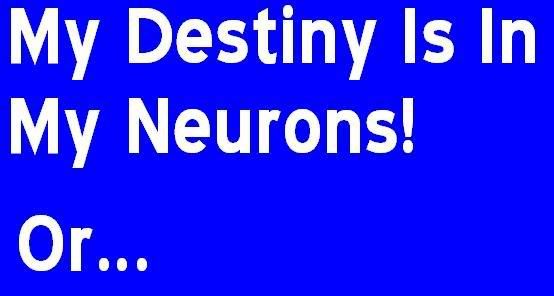

[size=40]Day Of The Dead, 1985 United Film Distribution Company[/size]



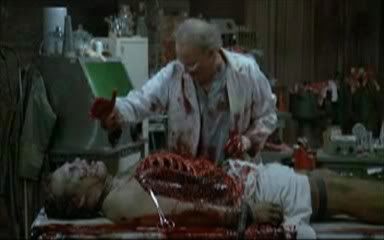
[size=135]“The brain is the engine, Sarah….the motor that drives them!”[/size]
[size=90]Dr. “Frankenstein” Logan (Richard Liberty) to the protagonist (Lori Cardille) of George Romero’s zombie epic: Day Of The Dead, 1985[/size]

Welcome my son,
Welcome,
To The Machine…
-Pink Floyd
[size=130]Psychophysicalism is[/size] [b]the view that the physical brain is the sole arbiter of conscious experience. If psychophysicalism is true, everything that one believes or comes to believe, every “outmoded” idea of the past to every “progressive” idea of the present or future; every thought; every or act of volition depends upon electrical activity within physical objects called neurons.
In order to for an individual to experience, for example, the belief that God does not exist and the Bible is a book of myths and fairy tales, the person sustaining such a belief must first have a set of neurons corresponding to the belief installed beforehand. Without these neurons in place, ready to function at a moments notice, the relevant belief cannot arise within the mind of the subject.[/b]
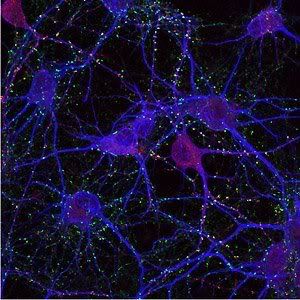
Neural systems that represent or give rise to a particular conscious experience are called neural correlates of consciousness (NCC):
What does it mean to be a neural correlate of consciousness? At first glance, the answer might seem to be so obvious that the question is hardly worth asking. An NCC is just a neural state that directly correlates with a conscious state, or which directly generates consciousness, or something like that. One has a simple image: when your NCC is active, perhaps, your consciousness turns on, and in a corresponding way. But a moment’s reflection suggests that the idea is not completely straightforward, and that the concept needs some clarification.
As a first pass, we can use the definition of a neural correlate of consciousness given in the program of the ASSC conference. This says a neural correlate of consciousness is a “specific system in the brain whose activity correlates directly with states of conscious experience”. This yields something like the following:
“A neural system N is an NCC if the state of N correlates directly with a state of consciousness.”
(Chalmers, David J: What Is A Neural Correlate Of Consciousness?, consc.net/papers/ncc2.html)
That is, if a subject is currently having experience x, it is an indication that the NCC correlating with experience x is currently in operation. Amazingly, for every experience of the past, present, or future there is an NCC. According to psychophysicalism, there must be an NCC to answer for any conscious experience arising within a subject, as it is believed that consciousness only arises from the operation of physical matter.
At bottom, Hayek is a materialist. For him, there is no mind-body split. Instead, all our thoughts, memories, and ambitions result from the operation of matter. Indeed, for Hayek, “the assertion that…mental phenomena are ‘nothing but’ certain complexes of physical events [is] probably defensible” (1989, p88). Or more assertively, “mind is…the order prevailing in a particular part of the physical universe—that part of it which is ourselves” (1952, p178).
(Dempsey, Gary T: Hayek’s Evolutionary Epistemology, Artificial Intelligence, and the Question of Free Will, cato.org/pubs/wtpapers/hayekee.html).
[size=150]Great Caesars Ghost!..There’s An NCC For THIS Too?[/size]

Figure 1. What a strange world we live in! If the brain (specifically, the neocortex) is the sole arbiter of consciousness, here lies evidence that there exists an NCC corresponding to the desire to drink one’s menstruated blood (mixed with other things)! If psychophysicalism is true, it’s perversely awe-inspiring that the laws of physics of our particular universe are capable of producing brains that contain this bizarre NCC!
Imagine that! There’s an NCC for the most outrageous, perverse, and traumatic experience. There’s an NCC for every infantile sexual fantasy, every horrific state of terror or rage, every base fear. And its prepared within the neocortex in advance of the experience itself! The neural circuits corresponding to even the most perverse behaviors and feelings must be in place within the cerebral cortex “ready to go” BEFORE THE FACT—or the conscious experience cannot arise.

[b]More remarkable is the fact that if there is no teleology behind the structure and function of the brain, the formation of these pre-existing NCCs and the absurd experiences to which they give rise occurs through sheer physical coincidence!
The coincidence lies in the blind “routing” of nerve impulses from the peripheral nervous system to the neocortex, which carries the neural machinery responsible for every cognitive experience. The NCCs blindly “compete”: NCCs in proximity stand by for the “lottery result” brought about by an incoming stimulus that may activate one NCC or another to give rise to a particular thought, feeling, volition, and behavior.[/b]
[size=130]Neuronal Predeterminism[/size]
For example, suppose an individual instantiates the thought: “God does not exist!” ten days prior to the individual’s fortieth birthday, in a moment of reflective catharsis during a morning stroll on the beach.

[b]If the brain is indeed responsible for consciousness, the relevant NCC responsible for the thought (“God does not exist!”) at time x (the morning walk on the beach) is electrochemically capable of performing the function before the fact (it’s “ready to go” before the individual thinks the thought), and it exists alongside neural circuits corresponding to other thoughts and beliefs.
(Other neural circuits, if physical chance permits, may have recieved the stimulus from the external world rather than the circuit corresponding to the cathartic thought on the beach)[/b]
Unless one is a dualist of a very strong variety, beliefs must be reflected in the [neural] functioning of a system – perhaps not in behavior, but at least in some process. While it might just seem plausible that an organization-preserving change from neurons to silicon [in a thought-experiment in which biological neurons of a still-conscious subject are removed one at a time and replaced with silicon chips capable of the same local function] might twist a few [visual] experiences from red to blue, a change in beliefs from “Nice basketball game” to “I seem to be stuck in a bad horror movie!” is of a different order of magnitude.
If such a major change in cognitive contents were not mirrored in a change in [neural] functional organization, cognition would float free of internal functioning like a disembodied mind. If the contents of cognitive states supervened on physical states at all, they could do so only by the most arbitrary and capricious of rules (if this organization in neurons, then “Pretty colors!”, if the same organization in silicon, then “Alas!”).
(Chalmers, David J: Absent Qualia, Fading Qualia, Dancing Qualia, consc.net/papers/qualia.html)
Given this, a question begs concerning how an NCC corresponding to the thought: “God does not exist” should come to exist within the cerebral cortex in the first place. In response, there are three distinct hypotheses that entail how an NCC forms within the neocortex (to obey the Broadway dictate of “Places everyone!”) before the appearance of its corresponding conscious experience:
1. Magical Preparation Of Future Neural Correlate
In Magical Preparation Of Future Neural Correlate, the NCC magically pops into existence ex nihilo, arriving in the nick of time to insinuate itself in the appropriate area of the neocortex (assuming appropriate synaptic connections with neurons in the vicinity) seconds before activation of the electrical impulse giving rise to the relevant subjective experience.
2. Historic Preparation Of Future Neural Correlate
In Historic Preparation, the NCC rests in it’s proper niche in the aftermath of brain development from childhood. The NCC bides it’s time, forming synaptic connections with other neural circuits to form other conscious experiences before forming the synaptic connections giving rise to the fateful cognition on the beach.
3. Johnny-On-The-Spot Preparation Of Future Neural Correlate
In Johnny-On-The-Spot Preparation, the relevant NCC does not exist until a week before the fateful walk on the beach. Old neurons in the area soon to be occupied by the new NCC die off, with new neurons assembled from the flotsam and jetsam of the old neurons—or from neurons formed through hippocampal neurogenesis (with the newly formed neurons pumped or channeled to the neocortex to synaptically connect with surviving neurons)forming the fateful NCC .
(Note: Many neuroscientists hold that neurogenesis cannot occur in the neocortex; neurogenesis is believed to occur only in the hippocampus. Thus, the notion that neurons formed in the hippocampus can travel to the neocortex is pure conjecture relying upon physical possibility and future research.)
The nervous system is not static. We know that synapses constantly break down and form anew. Each time a nerve cell dies, thousands of synaptic connections are destroyed. Learning also reflects in anatomy as new synapses, connections, form. You lose mental capacity with age, Alzheimer disease through the misuse of drugs and degeneration you are really destroying more and more synaptic connections between neurons. Thus, although you generally lose neurons with time and with them abundant synapses, you form others through learning and mental exercise. If you continue to learn as you age by doing problems, reading, and expanding your vocabulary, you will form new synapses. Adult life is a race between neuronal loss and synapse formation.
(Yanofsky, Charles: Beyond Biology, pneuro.com/publications/insi … part2.html)

Regardless of whether or not an NCC corresponding to the thought “God does not exist!” is formed during childhood through Historic Preparation or in the nick of time though Magical or Johnny-on-the-Spot Preparation, the individual on the beach has been PRE-PROGRAMMED [b] to experience thought x at time y.
This “pre-programming” is achieved through:
-
The absurd psychophysical partnerships between NCCs and conscious experiences
-
The mechanical set-up between NCCs, the physical body carrying the physical brain, and the external physical environment. Activation of a particular NCC at a particular time, at bottom, relies upon:
A. The accidental imposition of mechanical and electrical forces from the external world upon the body housing the brain (the forces strike the body at different angles and varying strengths)
B. The forces routing from the periphery of the body to the central nervous system through the sensory organs on the face and the spinal cord
C. The overall nervous routing system formed by neural connections between the brain, spinal cord, sensory receptors of the PNS, and the environment.
Given the unpredictability of the evolving circumstances between a living organism and its changing physical environment, there is a natural selection which determines which NCC will activate at a particular time (can two thoughts, for example, exist in the same mental space at the same time?) within a particular neural environment, given that a relevant NCC “competes” with other NCCs in the cortical vicinity for activation.[/b]


The basic schema for this neural selection process:
If x then possibly y, y1,y2, or y3 at time z
x = an electromechanical force transmitted from the physical environment to the sensory receptors under the skin, from the sensory receptors to the spinal cord, and from the spinal cord to the thalamus, the last relay station to the cerebral cortex and the entire gamut of NCCs corresponding to every thought or volition in the lifetime of a conscious subject.
y, y1,y2, or y3 = NCCs within the neocortex corresponding to different conscious thoughts and volitions lying in the vicinity of the incoming stimulus, with a “winner” activated by the incoming stimulus due to the trajectory of the stimulus in its route of travel from the thalamus to the area of the cerebral cortex containing the “winning” NCC.
For any “winner” NCC that activates, another NCC might have “won” (activated) in its place—had impulses from sensory receptors traveled a different route into the cortical arena.
[size=130]The External Environment Determines The Function Of The Cerebral Cortex! What We Think At A Certain Time Depends Upon The Force And Direction Of The Wind, The Heat Of The Sun, And Other Forces Exerted Against The Physical Body By The Surrounding Environment![/size]
The most surprising (and yet isn’t it obvious upon rational reflection?) induction from the above is that the operation of the human brain (and the cerebral cortex in particular) is ultimately dependent upon the sensory receptors receiving stimuli from the external environment. Virtually any non-destructive force exerted against the physical body (light, sound, heat, cold, and mechanical pressure and displacement) from the environment is “routed” through receptors in the form of nerve impulses to the spinal cord and brain.
Sense organs receive external and internal stimuli; therefore they are called receptors. Each type of receptor is sensitive to only one type of stimulus. Classified according to the kinds of stimuli that activate them, there are several types of receptors, including mechanoreceptors, activated by mechanical stimuli such as touch and pressure; thermoreceptors, activated by heat and cold; chemoreceptors, activated by various chemicals; and nociceptors, activated by intense stimuli of any kind.
Receptors are the first component of the reflex arc. When a receptor is stimulated, it generates nerve impulses that are transmitted to the spinal cord and/or brain; but only if the impulses reach the cerebrum are we conscious of a sensation. The particular sensation produced is the prerogative of the area of the brain that is stimulated, since the nerve impulse itself always has the same nature.
The thalamus is the last portion of the brain for sensory input before the cerebrum. It serves as a central relay station for sensory impulses traveling upward from other parts of the cord and brain to the cerebrum. It receives all sensory impulses (except those associated with the sense of smell) and channels them to appropriate regions of the cortex for interpretation. For this reason, the thalamus is sometimes called the gatekeeper to the cerebrum because it alerts the cerebrum to only certain sensory input, sorting out incoming stimuli and passing on only those that require immediate attention.
(Mader, Slyvia: Inquiry Into Life–Fourth Edition, Wm.C. Brown Publishers, Dubuque, Iowa 1976, 1979, 1982, 1985; Thibodeau, Gary A: Anatomy And Physiology, Times Mirror/Mosby College Publishing, St. Louis Toronto Santa Clara 1987)
[b]Remarkably, the forces continually impacting the human body are uncontrollable and unpredictable, yet the body of a living organism is fortuitously prepared to “route” these unpredictable forces from the periphery to the central nervous system in a way that fosters meaningful physical reaction to unpredictable events.
It follows that virtually every thought, decision, and act of volition at any moment in time will depend upon the trajectory of a reflex arc originating from sensory receptors (the trajectory determines the route of the impulse to the appropriate NCC)![/b]
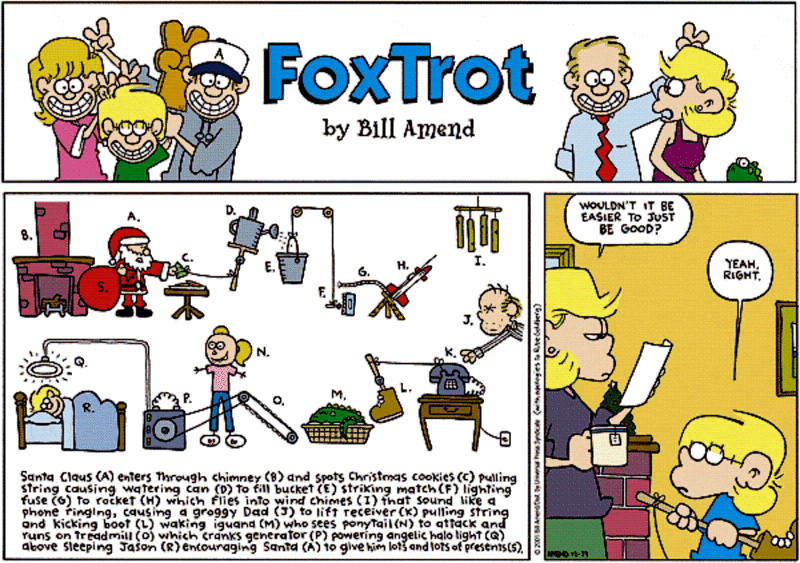
According to the literature, however, the function of the neocortex is not exclusively determined through the nervous routing system between the external environment, sensory receptors, and the CNS:
The route traveled by many nerve impulses is called a reflex arc. Basically, a reflex arc is an impulse conduction route to and from the central nervous system (the brain and spinal cord). In essence, a reflex arc is an impulse conduction route from receptors to the central nervous system and out to effectors.
(However) An important principle is this: all impulses that start in receptors do not invariably travel over a complete reflex arc and terminate in effectors. Many impulses fail to be conducted across synapses. Moreover, all impulses that terminate in effectors do not invariably start in receptors. Many of them, for example, are thought to originate in the brain.
(Thibodeau, Gary A: Anatomy And Physiology, Times Mirror/Mosby College Publishing, St. Louis Toronto Santa Clara 1987)
[b]If the neocortex functions independently of impulses originating in receptors, such non-receptor function does not arise ex nihilo. Electrical activity within the cortex independent of reflex arc originates from potential difference somewhere, perhaps in surplus electric charge in ionized intercellular proteins. One can argue, however, that such ionization is a residual effect of reflex arcs from receptors that successfully reach the cortex.
(Floating sustenance proteins between neurons (or the glial cells themselves) may possess ionization sufficient to collectively depolarize neural circuits in the neocortex independent of reflex arc)
Philosophically, it is remarkable that if no biology-creating God or gods exist, we are accidentally formed by blind forces “having no prevision of the end they were achieving” (Russell). We are mechanically “geared” to possess the thoughts and beliefs that we have in the form of a routing system consisting of the sensory receptors, the sensory organs, and the CNS.
This “shoot through here, my brain will think this—shoot through there, it will think that” causal relationship, it turns out, is shockingly analogous[/b] to the operation of a pinball machine.
(It is also analogous to the shooting of pool balls in a game of pool, with the external world the “cue stick” aiming toward the “pool balls” of sensory receptors and sensory organs to make the “side pocket” of neocortical NCCs in the cerebral cortex)
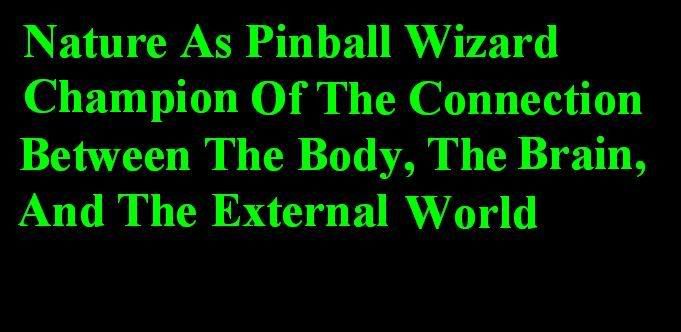
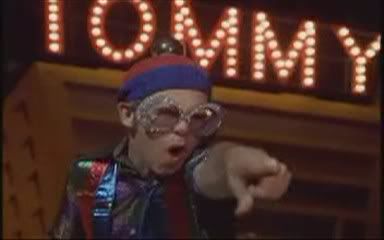
[i]He’s a pinball wizard
There’s got to be a twist
A pinball wizard
got such a supple wrist

How do you think he does it?
(I don’t know)
What makes him so good?

He ain’t got no distractions
Can’t hear those buzzers and bells
Don’t see lights a flashin’
Plays by sense of smell
Always gets a replay
Never tilts at all—[/i]
That deaf, dumb and blind kid
Sure plays a mean pinball…!

[size=85]-The Who: Pinball Wizard (song); Performed by Elton John in the film: Tommy (1975)[/size]
Whilst the Universe can at first seem be purposeful and ordered, it has been asserted that upon closer inspection its true function becomes questionable. Scientists such as Richard Dawkins, a high-profile advocate of atheism, attack the claim that the Universe serves any actual function, claiming that the Universe merely ‘mimics’ purpose. For example, predators appear perfectly ‘designed’ to catch their prey, whilst their prey seem equally well ‘designed’ to evade them. Likewise, apparent inconsistencies in the design of organisms have been brought to attention by critics of the teleological argument. Some use such arguments to point towards natural selection as a ‘blind’ biological designer, as opposed to God.*
(Wikipedia: Teleological Argument, en.wikipedia.org/wiki/Teleological_Argument)
[size=130]If non-teleological psychophysicalism[/size] [b]is the name of the game,
Nature is the proverbial “Tommy” [/b] : blind, deaf, dumb, and unknowingly playing a constant game of pinball with the “pinball machine” of the connection between external world environments, external-world bodies, and external-world brains. Forces exerted against the biological organism by the external environment:
: blind, deaf, dumb, and unknowingly playing a constant game of pinball with the “pinball machine” of the connection between external world environments, external-world bodies, and external-world brains. Forces exerted against the biological organism by the external environment:
-
Strike the sensory receptors (the pinball and pinball starter slot),

-
Route through the PNS (peripheral nervous system: the secondary ramps, bumpers, mazes, and targets in the pinball field beyond the starter slot)) to the CNS (the spinal cord, midbrain/hindbrain, and forebrain)—(the primary ramps, bumpers, mazes, and targets responsible for physical adaptation to the environment and conscious experience).
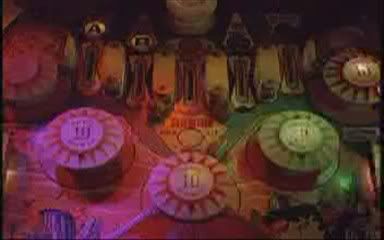

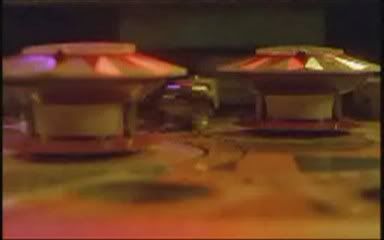
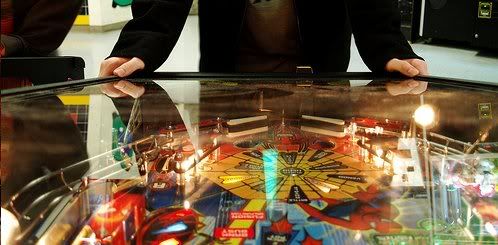
[size=150]Pre-Conclusion[/size]
[b]The upshot of Neural Predeterminism (the view that the entire destiny of a living organism is neurally pre-programmed) is this:
-
Every thought, feeling, and desire is physically “predestined” or pre-programmed through an interconnected network of NCCs (neural correlates of consciousness). An NCC responsible for a conscious experience must be present within the brain and chemically prepared to operate or the experience cannot arise.
-
The existence of a particular thought, feeling, choice, or desire at time x is primarily determined by nervous routes from the periphery of the physical body to the neocortex. Conscious experiences are determined primarily through random chance in the manner in which forces from the external environment act upon the body and brain, and which NCC happens to be “in the way” of a particular environment-to-body-to-brain transmission.
-
Electrical activity within the neocortex independent of reflex arcs do not exist in a vacuum, completely divorced from residual effects upon the chemistry of the brain by reflex arcs (from sensory receptors) to the cortex.
Despite the fact that many impulses are thought to originate deep within the brain, the electrical potential for non-receptor initiated impulse may derive from the electric residue of full reflex arcs. Even if an opponent were to argue that electric potential within intercellular proteins and glial cells suffices for some cortical function, a superhuman leap of logic (and faith) is required to insist that impulses independent of full reflex arc alone explains the existence of every thought, desire, and intention in the span of organismic existence.[/b]

Everything that is physical (if the physical exists) is directly or indirectly connected regardless of distance. The universe is a causal domino chain that constantly falls, stands, and falls again, with event x causing event y, event y causing event z, and so on.


Fictional “Existential Detective” Bernard Jaffe (Dustin Hoffman) presents an interesting analogy of universal connectedness to client Albert Markovski (Jason Schwartzman) in the film: I Heart Huckabees. Jaffe uses a blanket to represent the cosmos—describing all objects and people as “wrinkles” in the blanket connected by interstitial particle attraction.
[youtube]http://www.youtube.com/watch?v=UbYHyosA3sk[/youtube]
Physical connectedness is implied in the physical and phenomenal fact that the content of thoughts, feelings, and intentions seem to reflect the content of visual experience. Physical/mental correlation in psychophysical theory demands that environment-reflection implies a physical connection between the universe, the current environment, the body of the organism, and the cerebral cortex.
[size=150]Conclusion[/size]
[b]Ultimately, non-teleological explanation for the relationship between the external environment, the physical body, and the cerebral cortex relies upon coincidence, given the unrepeatable nature of atomic interaction and the vast number of atoms occupying a space at any given time. One must have faith that swarms of atoms in a particular area of space somehow managed to finally “do the right thing” to accidentally give rise to the psychophysical set-up. Reliance upon coincidence lies in the facts (if they are facts) that:
a. The body and brain of a conscious organism is constructed by unknowing atoms combining here and repelling there to blindly “sculpt” self-replicating cells, multicellular organisms, and cerebral cortices.
b. Physical bodies resulting from such interactions, by the most amazing coincidence, are mechanically prepared to route or “maze” the unpredictable and random forces exerted against the physical body by the surrounding environment into electrical signals activating neural circuits in the neocortex that create meaningful response to the unpredictable environment.
c. The neocortex evolved in such a way that it contains (or gains in the nick of time) neural system corresponding to every thought, feeling, choice, and belief that an individual will ever experience, with an entire lifetime of NCCs in the brain before the fact, prepared to mechanize one’s fate.[/b]
[size=130]Epilogue: A Simple Faith[/size]
[b]In the end, to believe that such the environmental/neural set-up evolved from the blind interactions of a googleplex of atoms in space and time requires an amazing chain of coincidences requiring quasi-religious faith of a greater magnitude than that needed for belief in the existence of a Deity.
The most significant consequence of psychophysicalism is its implications for free will. As Gary T. Dempsey states concerning Frederick Hayek’s Neural Darwinism:[/b]
Hayek’s view that the mind is a complex adaptive system or “spontaneous order” holds a significant implication for the age-old controversy about free will—defined as a will that is not the exclusive and necessary result of the interaction of physical material (one could extrapolate this definition to state that free will is a will that is not the exclusive and necessary result of any cause)* As far as we have seen, the mind consists of matter and its relations, and since everything can be realized in these materialist terms, there is simply no room for freedom of will. Indeed, it is another way of saying that our choices, judgments, and decisions are determined by the operation of the material that constitutes ourselves and the world, or as Oxford scholar John Gray summarizes Hayek’s view, “our ideas are merely the visible exfoliation of spontaneous forces” (1986, p30).
(Dempsey, Gary T: Hayek’s Evolutionary Epistemology, Artificial Intelligence, and the Question of Free Will, cato.org/pubs/wtpapers/hayekee.html).
[size=150]End[/size]